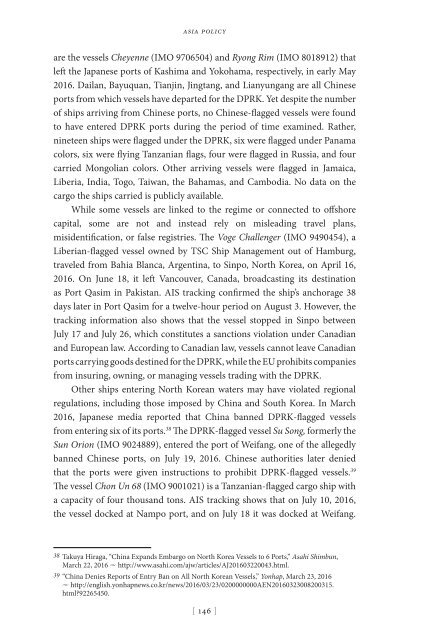2jBVKVf
2jBVKVf
2jBVKVf
You also want an ePaper? Increase the reach of your titles
YUMPU automatically turns print PDFs into web optimized ePapers that Google loves.
asia policy<br />
are the vessels Cheyenne (IMO 9706504) and Ryong Rim (IMO 8018912) that<br />
left the Japanese ports of Kashima and Yokohama, respectively, in early May<br />
2016. Dailan, Bayuquan, Tianjin, Jingtang, and Lianyungang are all Chinese<br />
ports from which vessels have departed for the DPRK. Yet despite the number<br />
of ships arriving from Chinese ports, no Chinese-flagged vessels were found<br />
to have entered DPRK ports during the period of time examined. Rather,<br />
nineteen ships were flagged under the DPRK, six were flagged under Panama<br />
colors, six were flying Tanzanian flags, four were flagged in Russia, and four<br />
carried Mongolian colors. Other arriving vessels were flagged in Jamaica,<br />
Liberia, India, Togo, Taiwan, the Bahamas, and Cambodia. No data on the<br />
cargo the ships carried is publicly available.<br />
While some vessels are linked to the regime or connected to offshore<br />
capital, some are not and instead rely on misleading travel plans,<br />
misidentification, or false registries. The Voge Challenger (IMO 9490454), a<br />
Liberian-flagged vessel owned by TSC Ship Management out of Hamburg,<br />
traveled from Bahia Blanca, Argentina, to Sinpo, North Korea, on April 16,<br />
2016. On June 18, it left Vancouver, Canada, broadcasting its destination<br />
as Port Qasim in Pakistan. AIS tracking confirmed the ship’s anchorage 38<br />
days later in Port Qasim for a twelve-hour period on August 3. However, the<br />
tracking information also shows that the vessel stopped in Sinpo between<br />
July 17 and July 26, which constitutes a sanctions violation under Canadian<br />
and European law. According to Canadian law, vessels cannot leave Canadian<br />
ports carrying goods destined for the DPRK, while the EU prohibits companies<br />
from insuring, owning, or managing vessels trading with the DPRK.<br />
Other ships entering North Korean waters may have violated regional<br />
regulations, including those imposed by China and South Korea. In March<br />
2016, Japanese media reported that China banned DPRK-flagged vessels<br />
from entering six of its ports. 38 The DPRK-flagged vessel Su Song, formerly the<br />
Sun Orion (IMO 9024889), entered the port of Weifang, one of the allegedly<br />
banned Chinese ports, on July 19, 2016. Chinese authorities later denied<br />
that the ports were given instructions to prohibit DPRK-flagged vessels. 39<br />
The vessel Chon Un 68 (IMO 9001021) is a Tanzanian-flagged cargo ship with<br />
a capacity of four thousand tons. AIS tracking shows that on July 10, 2016,<br />
the vessel docked at Nampo port, and on July 18 it was docked at Weifang.<br />
38 Takuya Hiraga, “China Expands Embargo on North Korea Vessels to 6 Ports,” Asahi Shimbun,<br />
March 22, 2016 u http://www.asahi.com/ajw/articles/AJ201603220043.html.<br />
39 “China Denies Reports of Entry Ban on All North Korean Vessels,” Yonhap, March 23, 2016<br />
u http://english.yonhapnews.co.kr/news/2016/03/23/0200000000AEN20160323008200315.<br />
html?92265450.<br />
[ 146 ]


